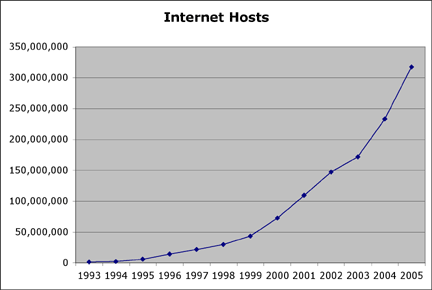More People on the Net More Often
Although the Internet has existed, in one form or another, since the 1960s, it was not until 1995 or so that it really started growing. Statistics on the total number of Internet users are, as you might expect, hard to come by, but the number of Internet hosts is much easier to ascertain.
An Internet host is a specific computer directly connected to the Internet, with its own specific Internet address (as opposed to one assigned from a pool).
The number of Internet hosts can be determined through what is pretty much a computer-driven census. Between 1995 and early 2005, this number grew from 5 million to more than 300 million. That’s a growth of nearly 60 times in ten years, or more than 50 percent a year (Figure 2.1).

Figure 2.1 A look at the number of Internet hosts per year.
If you’re interested in a more people-centric figure, the 300 million hosts in early 2005 translate to about a billion users. And the trend is expected to continue.
In addition to this rapid increase in the number of users, folks are staying online for longer periods of time. There are several reasons for this, including that there’s more to see and do on the Web than there was before. According to AOL, for instance, the average amount of time a user stayed on its system went up about 5 times between 1996 and 2000.
The main reason, however, why people are staying online longer—and certainly the one that’s most relevant to security—is that many of today’s high-speed (broadband) connections allow users to remain on 24 hours a day, if they want. The FCC estimates that the number of users on such high-speed connections in the United States tripled in less than three years, to nearly 50 million in late 2004. We’ll talk more about the many additional security ramifications of permanent high-speed connections later in this chapter, but they’re causing the Net to be used a whole lot more by a whole lot more users.